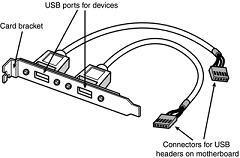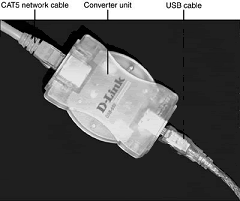USB Connectors
Four main styles of connectors are specified for USB, called Series A, Series B, Mini-A, and Mini-B connectors. The A connectors are used for upstream connections between a device and the host or a hub. The USB ports on motherboards and hubs are usually Series A connectors. Series B connectors are designed for the downstream connection to a device that has detachable cables.
In all cases, the mini connectors are simply smaller versions of the larger ones, in a physically smaller form factor for smaller devices. The physical USB plugs are small (especially the mini plugs) and, unlike a typical serial or parallel cable, the plug is not attached by screws or thumbscrews. There are no pins to bend or break, making USB devices very user friendly to install and remove.

Note that a Mini-A/B socket is a dual-purpose socket that can accept either Mini-A or Mini-B plugs. The newer mini plugs and sockets have plastic portions inside the connectors that are required to be color-coded.
USB conforms to Intel's Plug and Play (PnP) specification, including hot plugging, which means that devices can be plugged in dynamically without powering down or rebooting the system.
Simply plug in the device, and the USB controller in the PC detects the device and automatically determines and allocates the required resources and drivers.
Microsoft has developed USB drivers and included them automatically in Windows 98 and later. Windows 95B and 95C have very limited support for USB 1.1; the necessary drivers are not present in the original Windows 95 or 95A. With Windows 95B, the USB drivers are not automatically included; they are provided separately, although a late release of Windows 95—Windows 95C—includes USB support.
Many USB devices will not work with any Windows 95 release, including those that have the USB support files included. Windows 98 and later have USB 1.1 support built in; however, additional drivers are required for USB 2.0 or later. In most cases, these drivers can be downloaded from Microsoft using the Windows Update feature.
USB support is also required in the BIOS for devices such as keyboards and mice. This is included in all newer systems with USB ports built in. Aftermarket PCI and PC Card boards also are available for adding USB to systems that don't include it as standard on the motherboard. USB peripherals include printers, CD-ROMs, modems, scanners, telephones, joysticks, keyboards, and pointing devices such as mice and trackballs.
A free utility called USBready is available; it examines your PC's hardware and software and informs you of your PC's USB capabilities. Most PCs built in 1995 or earlier don't support USB. During 1996 most PC motherboards began supporting USB, and if your system dates from 1997 to 1998 or later, USB support is almost a certainty.
One interesting feature of USB is that, with certain limitations, attached devices can be powered by the USB bus. The PnP aspects of USB enable the system to query the attached peripherals as to their power requirements and issue a warning if available power levels are being exceeded.
This is important for USB when it is used in portable systems because the battery power that is allocated to run the external peripherals might be limited. You can determine the amount of power available to each port in a USB root or generic hub and the amount of power required by a USB peripheral with the Windows Device Manager.
Devices that use more than 100mA, such as the Webcam must be connected to a root hub or a self-powered generic hub. Devices that use 100mA or less can be connected to bus-powered hubs, such as those built in to some keyboards and monitors. To avoid running out of power when connecting USB devices, use a self-powered hub.
Another of the benefits of the USB specification is the self-identifying peripheral, a feature that greatly eases installation because you don't have to set unique IDs or identifiers for each peripheral—the USB handles that automatically. Also, USB devices can be "hot" plugged or unplugged, meaning that you do not have to turn off your computer or reboot every time you want to connect or disconnect a peripheral.
However, to prevent data loss with USB drives and storage devices, you need to use the Eject Hardware or Safely Remove Hardware feature in the Windows system tray. Click the device, select Stop, click OK, and wait for the system to indicate that the device has been stopped before you remove it.
Enabling USB Support
Many systems shipped before Windows 98 was introduced in mid-1998 have onboard USB ports that were disabled at the factory. In some cases, especially with Baby-AT motherboards, there is no way to tell from the outside which systems have USB support built in.
This is because many of these same systems were not shipped with the USB header cables necessary to bring the USB root hub connectors from the motherboard to the rear of the system. If USB support is disabled in the system BIOS, restart your system and locate the BIOS setup screen that refers to the USB ports. Enable the USB feature.
If you see a separate entry for USB IRQ, enable this as well. After you restart the computer with a USB-aware operating system, your "new" USB root hub will be detected and the drivers will be installed if you are using Windows 98 or newer; you might need to manually install drivers with late releases of Windows 95.
If your system has USB connectors present, you also will be able to use the "new" USB ports as soon as the system is rebooted after the USB drivers are installed. However, if your motherboard vendor didn't provide USB connectors, you must buy USB header cables.
Before you order them, check the configuration of your motherboard's USB header pins. The standard is two rows of five pins each. Companies such as Belkin, CyberGuys, and Cables To Go sell header cables that are compatible with standard USB header pins if your motherboard supplier doesn't have the header cable in stock.

One of the biggest advantages of an interface such as USB is that it requires only a single interrupt (IRQ) from the PC. Therefore, you can connect up to 127 devices and they will not use separate interrupts, as they might if each were connected over a separate interface. This is a major benefit of the USB interface.
USB 2.0/Hi-Speed USB
USB 2.0 (also called Hi-Speed USB) is a backward-compatible extension of the USB 1.1 specification that uses the same cables, connectors, and software interfaces, but it runs 40 times faster than the original 1.0 and 1.1 versions.
The higher speed enables higher-performance peripherals, such as higher-resolution Web/videoconferencing cameras, scanners, and faster printers, to be connected externally with the same easy plug-and-play installation of current USB peripherals. From the end-user point of view, USB 2.0 works exactly the same as 1.1—only faster and with more interesting, higher-performance devices available.
All existing USB 1.1 devices work in a USB 2.0 bus because USB 2.0 supports all the slower-speed connections. If your motherboard or system features USB 2.0–compatible (Hi-Speed USB) ports, you might need to enable USB 2.0/Hi-Speed USB support in the system BIOS and install an appropriate driver. Otherwise, USB 2.0/Hi-Speed USB ports will be used as USB 1.1 ports.
The support of higher-speed USB 2.0 peripherals requires using a USB 2.0 hub. You can still use older USB 1.1 hubs on a 2.0 bus, but any peripherals or additional hubs connected downstream from a 1.1 hub will operate at the slower 1.5MBps USB 1.1 maximum speed. Devices connected to USB 2.0 hubs will operate at the maximum speed of the device, up to the full USB 2.0 speed of 60MBps.
The higher transmission speeds through a 2.0 hub are negotiated on a device-by-device basis, and if the higher speed is not supported by a peripheral, the link operates at a lower USB 1.1 speed. As such, a USB 2.0 hub accepts high-speed transactions at the faster USB 2.0 frame rate and must deliver them to high-speed USB 2.0 peripherals as well as USB 1.1 peripherals.
This data rate matching responsibility requires increased complexity and buffering of the incoming high-speed data. When communicating with an attached USB 2.0 peripheral, the 2.0 hub simply repeats the high-speed signals; however, when communicating with USB 1.1 peripherals, a USB 2.0 hub buffers and manages the transition from the high speed of the USB 2.0 host controller (in the PC) to the lower speed of a USB 1.1 device.
This feature of USB 2.0 hubs means that USB 1.1 devices can operate along with USB 2.0 devices and not consume any additional bandwidth. Some manufacturers of add-on USB 2.0 cards are equipping the cards with both external and internal USB 2.0 ports.
How can you tell which devices are designed to support USB 1.1 and which support the emerging USB 2.0 standard? The USB Implementer's Forum (USB-IF), which owns and controls the USB standard, introduced new logos in late 2000 for products that have passed its certification tests.

As you can see, USB 1.1 is also known simply as USB, and USB 2.0 is also known as Hi-Speed USB. Also note the icons shown earlier, where the addition of the plus symbol to the standard USB trident is used to identify ports that support USB 2.0.
USB On-The-Go
In December 2001, the USB-IF released a supplement to the USB 2.0 standard called USB On-The-Go. It was designed to address the one major shortcoming of USB: the fact that a PC was required to transfer data between two devices. In other words, you couldn't connect two cameras together and transfer pictures between them without a PC orchestrating the transfer.
With USB On-The-Go, however, devices that conform to the specification still work normally when they are connected to a PC, but they also have additional capabilities when connected to other devices supporting the standard. Although this capability can also work with PC peripherals, it was mainly added to address issues using USB devices in the consumer electronics area, where a PC might not be available.
Using this standard, devices such as digital video recorders can connect to other recorders to transfer recorded movies or shows, items such as personal organizers can transfer data to other organizers, and so on. The addition of the On-The-Go supplement to USB 2.0 greatly enhances the use and capabilities of USB both in the PC and consumer electronics markets.
The first products using USB On-The-Go technologies are expected sometime in 2003; ATI's Imageon display coprocessor for PDAs and smart phones and Qualcomm's next-generation wireless chipsets are among early adopters of this technology.
USB Adapters
If you still have a variety of older peripherals and yet you want to take advantage of the USB connector on your motherboard, several signal converters or adapters are available. Companies such as Belkin and others currently have adapters in the following types:
-
USB-to-parallel (printer)
-
USB-to-serial
-
USB-to-SCSI
-
USB-to-Ethernet
-
USB-to-keyboard/mouse
-
USB-to-TV/video
These adapters usually look just like a cable, with a USB connector at one end (which you plug into your USB port) and various other interface connectors at the other end. In some cases, you attach standard USB and device cables to a standalone adapter, such as with the USB-to-Ethernet adapter.

There is more to these devices than just a cable: If the unit is a one-piece device, active electronics are hidden in a module along the cable or are sometimes packed into one of the cable ends. The electronics are powered by the USB bus and convert the signals to the appropriate other interface. If you cannot install a native adapter card for your device, converting it to use the USB port through an adapter is much better than not using the device at all.